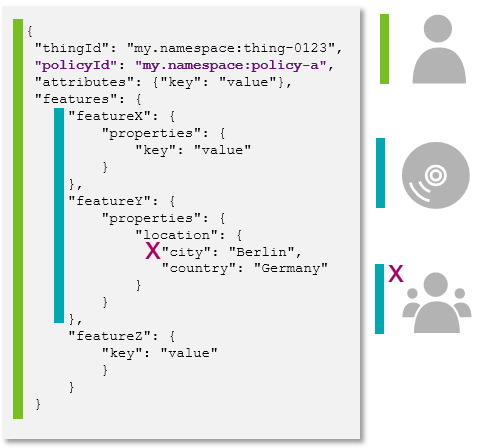Policies resources
An IoT developer can create, read, update and delete a Policy via the version 2 of the HTTP API.
Policies resource
By default a policy is related to a thing or another entity. However, policies have their own lifecycle:
- While creating a thing without explicit policy assignment, a default policy is created. Thus, the creator will aquire all permissions to fully control the thing and the policy. In such a case the Policy ID equals the Thing ID.
- Deleting a policy does not implicitly delete other entities (e.g. Things) which use the policy.
Example
Given you need to support the following scenario:
- Owner: The thing
my.namespace:thing-0123is owned by a user. Thus, he needs full access and admin rights for the complete thing.
In our example his ID is 8c36bc60-xxxx-xxxx-xxxx-4ed6ce7ed64c - Observer of changes at featureX and featureY:
- Another application needs to be informed on each change at those features. In our example its ID is eebbb40e-xxxx-xxxx-xxxx-f79a4653946b:observer-client.
- There is a group of users who are allowed to read both features. In our example the group ID is 93f24210-xxxx-xxxx-xxxx-620a03644e93
- Privacy The value of the “city” property at “featureY” is confidential and needs to be “hidden” from the group of users.

 Find the complete policy in JSON notation at
Policy - example
Find the complete policy in JSON notation at
Policy - example
Note on policy ID and labels
Each policy ID needs to follow the pattern <namespace>:<policy-name>.
 Due to the fact that a policy ID or label might need
to be set in the path, we have restricted the set of allowed characters
to those for Uniform Resource Identifiers (URI) see
http://www.ietf.org/rfc/rfc2396.txt.
Due to the fact that a policy ID or label might need
to be set in the path, we have restricted the set of allowed characters
to those for Uniform Resource Identifiers (URI) see
http://www.ietf.org/rfc/rfc2396.txt.
Note on conditional requests
The Policies resources support Conditional Requests. Details are described in the Ditto HTTP API concepts.
Tip on subject placeholder
 While creating a policy via the HTTP API, it might be
cumbersome to find out your own technical ID, which is crucial to add to
the policy, in order to still have permission to edit it at a later
point in time. For such a case you can use the placeholder
While creating a policy via the HTTP API, it might be
cumbersome to find out your own technical ID, which is crucial to add to
the policy, in order to still have permission to edit it at a later
point in time. For such a case you can use the placeholder {{ request:subjectId }}. Once the request was processed at the Things
service it will be replaced with the ID of the requesting user.
For creating permissions for connected devices (e.g. via Bosch IoT Hub),
you can use the placeholder {{ request:solutionId }},
e.g.
integration:{{ request:solutionId }}:hub.
Tip on how to derive the subject from your JWT
You can find the subject IDs for your current authentication, using the Who Am I-REST call.
Find the resource in the API docs, at the end of the Policies section
See also FAQ > How to find the authorization subject IDs that I can use in policies?
